2022 | OriginalPaper | Chapter
Comparative Evaluation of Classification Indexes and Outlier Detection of Microcytic Anaemias in a Portuguese Sample
Authors : Beatriz N. Leitão, Paula Faustino, Susana Vinga
Published in: Progress in Artificial Intelligence
Publisher: Springer International Publishing
Activate our intelligent search to find suitable subject content or patents.
Select sections of text to find matching patents with Artificial Intelligence. powered by
Select sections of text to find additional relevant content using AI-assisted search. powered by
